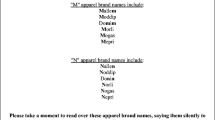Abstract
We examine decision makers’ use of tacit linguistic intuitions and explicit linguistic knowledge for brand name translations from English to Chinese. We present a market study, which reveals that managers intuitively use linguistic sound and meaning characteristics, that is, which sounds and meanings best fit for the Chinese translation of the English names. A subsequent experiment shows that generalized types of existing name approaches (that is, whether the names are translated based on sound or based on meaning) are employed as explicit benchmark standards for new names. The results of the two studies suggest that brand naming is a process that involves accessing deeply engrained linguistic structures, as well as explicit linguistic knowledge and rules. We suggest directions for future research on name translation and discuss practical applications of our findings.

Similar content being viewed by others
References
Akmajian, A., Demers, R.A., Farmer, A.K. and Harnish, R.M. (1992) Linguistics: An Introduction to Language and Communication. Cambridge, MA: MIT Press.
Baumard, P. and Wauchope, S. (1999) Tacit Knowledge in Organizations. Oakland Hills, CA: Sage Publications.
Chomsky, N. (1957) Syntactic Structures. The Hague, the Netherlands: Mouton Publishers.
Chomsky, N. (1965) Aspects of the Theory of Syntax. Cambridge, MA: MIT Press.
Francis, J., Lam, J. and Walls, J. (2002) The impact of linguistic differences on international brand name standardization: A comparison of English and Chinese brand names of Fortune-500 companies. Journal of International Marketing 10 (1): 98–116.
Fromkin, V. and Rodman, R. (1993) An Introduction to Language. Orlando, FL: Harcourt Brace Jovanovich Colleague Publishers.
Grant, R. (1996) Toward a knowledge-based theory of the firm. Strategic Management Journal 17 (1): 109–122.
Helm, B. (2009) The dubbing of ‘Bing’. BusinessWeek 15 June.
Holbrook, M.B. and Batra, R. (1987) Assessing the role of emotions as mediators of consumer responses to advertising. Journal of Consumer Research 14 (4): 404–420.
Holbrook, M.B. and Lehmann, D.R. (1980) Form versus content in predicting starch scores. Journal of Advertising Research 20 (4): 53–62.
Kakabadse, N.K., Kouzmin, A. and Kakabadse, A. (2001) From tacit knowledge to knowledge management: Leveraging invisible assets. Knowledge and Process Management 8 (3): 137–154.
Keller, K.L., Heckler, S. and Houston, M. (1998) The effects of brand name suggestiveness on advertising recall. Journal of Marketing 62 (1): 48–57.
Klink, R.R. (2000) Creating brand names with meaning: The use of sound symbolism. Marketing Letters 11 (1): 5–20.
Klink, R.R. (2003) Creating meaningful brands: The relationship between brand name and brand mark. Marketing Letters 14 (3): 143–157.
Lerman, D. and Garbarino, E. (2002) Recall and recognition of brand names: A comparison of word and nonword name types. Psychology and Marketing 19 (7–8): 621–639.
Li, Z.G. and Murray, L.W. (2002) Naming products in China: Local or foreign branding. Journal of Asia-Pacific Business 3 (3): 53–71.
Nonaka, I. and Takeuchi, H. (1995) The Knowledge-Creating Company. New York: Oxford University Press.
Nonaka, I., Toyama, R. and Byosiere, P. (2001) A theory of organizational knowledge creation: Understanding the dynamic process of creating knowledge. In: M. Dierkes, A. Antal-Berthoin, J. Child and I. Nonaka (eds.) Handbook of Organizational Learning and Knowledge Creation. Oxford: Oxford University Press, pp. 491–517.
Pan, Y. and Schmitt, B.H. (1994) What's in a name? An empirical comparison of Chinese and Western brand names. Asian Journal of Marketing, 11 (3): 7–16.
Polanyi, M. (1966) The Tacit Dimension. London: Routledge & Kegan Paul.
Schmitt, B.H. and Pan, Y. (1994) Managing corporate and brand identities in the Asia-Pacific region. California Management Review 36 (4): 32–48.
Schmitt, B.H., Pan, Y. and Tavassoli, N. (1994) Language and consumer memory: The impact of linguistic differences between Chinese and English. Journal of Consumer Research 21 (3): 419–431.
Tavassoli, N. (1999) Temporal and associative memory in Chinese and English. Journal of Consumer Research 26 (2): 170–181.
Zhang, S. and Schmitt, B.H. (2001) Creating local brands in multilingual international markets. Journal of Marketing Research 38 (2): 313–325.
Zhang, S. and Schmitt, B.H. (2004) Activating sound and meaning: The role of language proficiency in bilingual consumer environments. Journal of Consumer Research 31 (June): 220–228.
Author information
Authors and Affiliations
Additional information
1holds a PhD and is the Robert D. Calkins Professor of International Business at Columbia Business School in New York. He is also the Faculty Director of the Center on Global Brand Leadership at Columbia and Executive Director of the Institute on Asian Consumer Insights at Nanyang Technological University in Singapore. He is author of several books including Big Think Strategy and Customer Experience Management. His research, which focuses on language, brands and experience, has been published in more than 50 articles in leading marketing journals.
2holds PhDs in both linguistics and marketing. He is Associate Professor of Marketing at UCLA. He has done innovative research in the area of market-entry strategy and marketing communications, and in the area of brand naming and positioning in the international market. His research has been published in all the major marketing journals.
Rights and permissions
About this article
Cite this article
Schmitt, B., Zhang, S. Selecting the right brand name: An examination of tacit and explicit linguistic knowledge in name translations. J Brand Manag 19, 655–665 (2012). https://doi.org/10.1057/bm.2011.62
Received:
Revised:
Published:
Issue Date:
DOI: https://doi.org/10.1057/bm.2011.62




